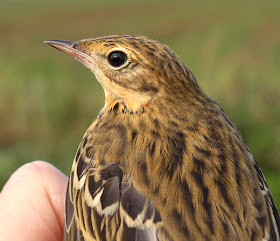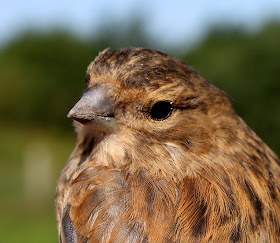Three days of grotty weather finally gave way to a decent wind and rain free morning so Will and I met up on the moss at 6am for yet another bash at catching some migrant birds. In the dawn light Will spotted a Roe Deer not too far away from our net rides so we deliberately made a bit of noise as we put the nets up, not wanting a repeat of the last visit when a deer ran through a net.
We caught steadily from the off, five or six birds on each round until we finished at 11am with a final tally of 41 birds of 11 species, 36 new and 5 recaptures. New birds: 11 Chaffinch, 11 Linnet, 3 Blackcap, 3 Whitethroat, 2 Goldfinch, and then one each of Blackbird, Blue Tit, Treecreeper, Chiffchaff, Tree Pipit and Grasshopper Warbler. Recaptures: 3 Whitethroat, 1 Blackbird and 1 Blackcap, all five of them ringed quite recently.
Although we have seen and heard the occasional Grasshopper Warbler here, today’s juvenile was the first “gropper” ringed at the site since we began work here in 2003.


We didn’t catch a single Blackcap here in April or May but since mid-June we have ringed 32 individuals, with one of today’s birds a fine, recently moulted, glossy headed, adult male.

Today's Chiffchaff made just 8 for the year, but we didn’t catch a Willow Warbler to add to the current total of 118 for that species here in 2011.

Today’s Tree Pipit was in the “finch net”, with the Grasshopper Warbler in the “pipit net”. We had at least two other Tree Pipits close to the nets without catching them, and in all a minimum of 6 birds “over” and heading south.

We targeted Chaffinch and Linnet today, Linnet because of the 200+ birds feeding in nearby fields, and Chaffinch because of their now growing numbers taking part in visible migration. In our five hour session we counted a minimum of 100 Chaffinch overhead and headed south, together with just a few Greenfinch. Today also proved to be the first signs of Meadow Pipit migration here, with just tiny groups and single birds on the move but those numbers added up to c35 birds arriving from the north or north east before they continued south. Now that "mipits" are on the move they will be added to target species for the next and subsequent visits.

Other birds seen today: 3 Raven, 1 Peregrine, 1 Kestrel, 3 Buzzard, c150 Swallows, 1 Great-spotted Woodpecker, 1 Grey Wagtail and 1 Alba wagtail.



















































